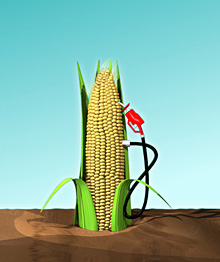
|  |  |  Editorials | Environmental Editorials | Environmental  
Energy Crops Impact Environmental Quality
 Sara Uttech - American Society of Agronomy Sara Uttech - American Society of Agronomy
go to original
April 05, 2010


| | What happens to the soil when you remove the plants? |  |
Madison, WI - Crop residues, perennial warm season grasses, and short-rotation woody crops are potential biomass sources for cellulosic ethanol production. While most research is focused on the conversion of cellulosic feeedstocks into ethanol and increasing production of biomass, the impacts of growing energy crops and the removal of crop residue on soil and environmental quality have received less attention. Moreover, effects of crop residue removal on soil and environmental quality have not been compared against those of dedicated energy crops.

In the March-April 2010 issue of Agronomy Journal, published by the American Society of Agronomy, Dr. Humberto Blanco reviewed the impacts of crop residue removal, warm season grasses, and short-rotation woody crops on critical soil properties, carbon sequestration, and water quality as well as the performance of energy crops in marginal lands. The review found that crop residue removal from corn, wheat,and grain sorghumcan adversely impact soil and environmental quality. Removal of more than 50% of crop residue can have negative consequences for soil structure, reduce soil organic carbon sequestration, increase water erosion, and reduce nutrient cycling and crop production, particularly in erodible and sloping soils.

"Crop residue removal can make no-till soils a source rather than a sink of atmospheric carbon," says Blanco, even at rates lower than 50%. Residue removal at rates of less than 25% can cause loss of sediment in runoff relative to soils without residue removal. To avoid the negative impacts on soil, perhaps only a small fraction of residue might be available for removal. This small amount of crop residues is not economically feasible nor logistically possible. Blanco recomends developing other alternative biomass feedstock sources for cellulosic ethanol production.

An alternative to crop residue removal is growing warm season grasses and short-rotation woody crops as dedicated energy crops. These crops can provide a wide of range of ecosystems services over crop residue removal. Available data indicate that herbaceous and woody plants can improve soil characteristics, reduce soil water and wind erosion, filter pollutants in runoff, sequester soil organic carbon, reduce net emissions of greenhouse gases, and improve wildlife habitat and diversity.

Whereas crop residue removal reduces carbon concentration, dedicated energy crops can increase soil organic carbon concentration while providing biofuel feedstock. Because of their deep root systems, warm season grasses also promote long-term carbon sequestration in deeper soil profile unlike row crops.

Growing dedicated energy crops in marginal and abandoned lands instead of prime agricultural fields will further benefit the soil and environment. Warm season grasses can grow in nutrient-depleted, compacted, poorly drained, acid, and eroded soils. Herbaceous and woody energy crops cannot replace natural forest and native prairie lands, but well-managed dedicated energy crops may provide a myriad of benefits to soil and environment while supplying much needed feedstocks for cellulosic ethanol production. Developing the next generation of biofuels will not only require new technologies to transform it into fuel, but new agricultural methods for growing it.

suttech(at)sciencesocieties.org

A peer-reviewed international journal of agriculture and natural resource sciences, Agronomy Journal is published six times a year by the American Society of Agronomy, with articles relating to original research in soil science, crop science, agroclimatology and agronomic modeling, production agriculture, and software. For more information visit: www.agron.scijournals.org.

The American Society of Agronomy (ASA) www.agronomy.org, is a scientific society helping its 8,000+ members advance the disciplines and practices of agronomy by supporting professional growth and science policy initiatives, and by providing quality, research-based publications and a variety of member services. |

 |
|  |



